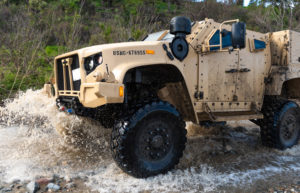CONCORD, N.C. — GM Defense [GM] is lining up partners and ensuring it has the full supply chain of parts necessary to compete for the Army’s follow-on production contract for the Joint Light Tactical Vehicle, a company official told
Defense Daily.
Rick Kewley, GM Defense’s chief engineer, said the company is in the process of working through the Technical Data Package (TDP) for JLTV, owned by the Army and not Oshkosh Defense [OSK], which builds the current platform, as it looks to take apart the vehicle and study how to piece it back together.

“Building and manufacturing the JLTV plays right into General Motors’ wheelhouse for where we have capability and where we can bring advanced quality and advanced manufacturing to the military market,” Kewley said. “We’re lining up partners to round out our business to make sure that we have all the capability that it takes to prove out the total vehicle.”
While Kewley said he could not disclose any specific partners as of now, he noted GM Defense is locking down the supply chain necessary to replicate the current JLTV design through its own manufacturing process.
“The tear down and build up of the vehicle is something that we will certainly be able to figure out and put together in a General Motors build process, and employ our own best practices through that. The hardest part is ensuring we can, from each of the existing suppliers, source and use the carryover parts. Those are complicated parts with complex integration. A ‘build-to-print’ data package isn’t really the total story on a specific part,” Kewley said.
The Army has laid out plans to competitively award the JLTV follow-on production deal, likely in 2022, as it looks to drive down production costs while deviating as little as possible from the current vehicle design (Defense Daily, Feb. 18 2020).
Kewley noted the focus on sticking with the current design lends an advantage to the incumbent, noting the challenge of having to seek out highly specific parts that are not readily available and may need to be redesigned for the manufacturing process.
“When you have to go and redesign that in the timeframe that exists between now and the RFP, that really turns into a significant demerit for anybody but the incumbent. So, we’re looking into getting all of the supply chain pieces for this vehicle, as ownership of the TDP would imply, but replicating that is more than the data,” Kewley said.
George Mansfield, Oshkosh Defense’s vice president and general manager for joint programs, told Defense Daily in February he was confident in the ability to secure the follow-on deal following an announcement of the company building the 10,000th JLTV (Defense Daily, Feb. 9).
“Since winning the JLTV contract in 2015, we knew we’d have to win it again. Oshkosh Defense is the proven partner of our U.S. military customer, and we’re building a great vehicle at a great cost,” Mansfield said at the time. “In order to win again, we’ve matured the manufacturing process, built a robust supply chain and maximized efficiencies. We’re confident in our ability to continue to deliver unmatched protection and off-road mobility at an affordable cost for many years to come.”
Kewley said adding the JLTV along with the company’s current work producing the Army’s new Infantry Squad Vehicle (ISV) would cement GM Defense as a primary vehicle producer for the U.S. military since reentering the defense market in 2017.
“In terms of volume and total award package size, it’s dramatic. It really brings another player into the defense tactical wheeled vehicle market. The ISV is an important program to us and we’re going to work through this initial fielding and I can see this vehicle being a mainstay [platform] for the U.S. military far into the future. We’d like to add to that with JLTV,” Kewley said.